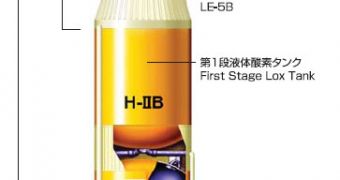In a move specifically meant to boost its international prestige, Japan unveiled last week its latest addition to the rocket fleet, the H-IIB, which is constructed by the giant corporation Mitsubishi Heavy Industries (MHI). Locked away securely in an air-tight cavernous hangar at a factory in the Aichi prefecture, near Nagoya, the booster now awaits its first launch, which will most likely take place this year. The main purpose of the new delivery system is, for now, to carry up to 6 tonnes of equipment to the International Space Station (ISS), via the use of the HTV, or H-2 Transfer Vehicle, spacecraft.
“We expect to make a trial launch toward the middle of this year if all the manufacturing and intermediary steps proceed well,” Japan Aerospace Exploration Agency (JAXA) project head Tomihisa Nakamura told a small crowd of journalists, who were finger-printed, subjected to an air shower and asked to wear chemical suits before entering the hangar. According to the official, when all the segments of the rocket are in place, it will be 56-meter (185-foot) tall, surpassing its sister rocket, the H-IIA, by more than 3 meters (10 feet).
The 5.2 meter (17 foot)-wide construction features a weight of approximately 530 tonnes, and boasts two main engines supported by four auxiliary thrusters. Once in orbit, JAXA officials said that they expected the vehicle to be capable of releasing a 16.5-tonne HTV, as well as satellites weighing a total of 8 tonnes. “These abilities are necessary to compete well internationally,” Nakamura added. In the end, the entire H-IIB project will cost in the vicinity of 40 billion yen ($444 million), a price that will be offset both by the Japanese space agency and by the industrial giant.
“The design costs are small compared to those of the H-2A, of an Ariane or another launcher, because we are reusing a lot of elements and knowledge gained from the H-2A. That also minimizes the risks. We have not yet decided how many successful launches the rocket will need for the MHI to begin using it for commercial purposes, such as putting private satellites into orbit. But, in the future, without doubt it will be used for missions of that nature,” the official stated.
At the moment, JAXA is plagued by the fact that its H-IIA rocket, although competitive, doesn't quite reach the prestige that Europe's Ariane came to enjoy over the last few years. In 2003, H-IIA's sixth mission failed, which delayed Japan's intentions of becoming a major player internationally. However, since 2005, the older rocket registered nine successful launches, which brought hope to a cash-strapped Japanese space agency.

 14 DAY TRIAL //
14 DAY TRIAL //